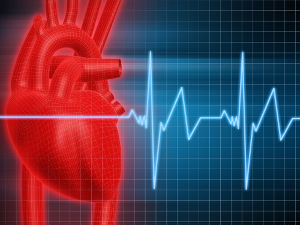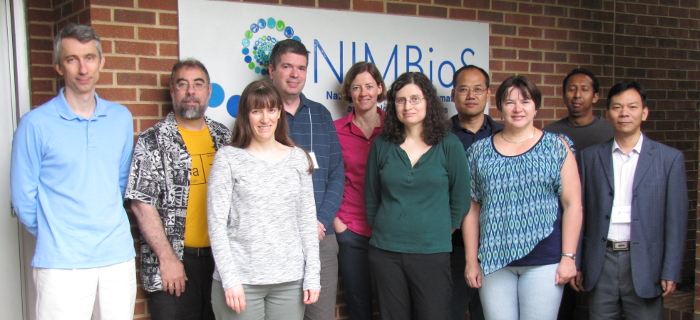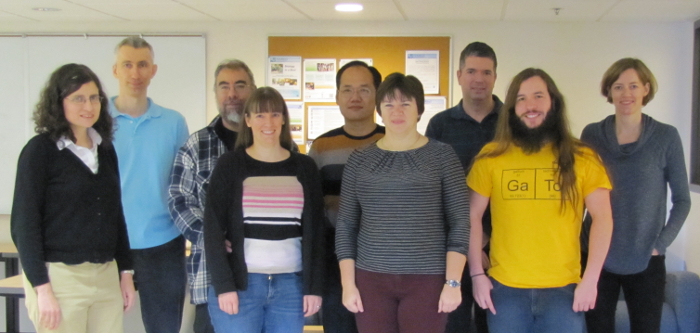| Description | Participants | Summaries | Products |
|---|
NIMBioS Working Group:
Prediction and Control of Cardiac Alternans

Topic: Prediction and Control of Cardiac Alternans
Meeting dates: May 2-4, 2016; December 14-16, 2016; December 11-13, 2017
Organizers:
Alena Talkachova, Biomedical Engineering, Univ. of Minnesota
Xiaopeng Zhao, Mechanical, Aerospace, and Biomedical Engineering, Univ. of Tennessee, Knoxville
Objectives: Cardiac alternans manifests at the cellular level as a beat-to-beat alternation in action potential duration (APD) and at the whole heart level as an alternating change in the amplitude or shape of the T-wave in the electrocardiogram (ECG). Cardiac alternans, which results from dynamical instability of the heart's electrical activities, is a precursor of complex cardiac rhythms, and specifically, ventricular fibrillation. It has been proposed that the onset of APD alternans could be predicted by analyzing the restitution properties of periodically paced cardiac myocytes. Several criteria have been developed to predict and to control APD alternans, but practical implementation is yet very limited.
Ideas for this working group benefited from discussions at the recent NIMBioS Investigative Workshop: Mathematical Modeling of Heart Rhythm Disorders, which took place on December 3-5, 2014, organized by Alena Talkachova, John Wesley Cain, and Xiaopeng Zhao. We aim to further investigate a few important problems identified at the Workshop. Specifically, we will (1) use a system-based approach to develop and test new algorithms for APD alternans prediction, both at cellular and tissue levels; (2) translate the criteria for predicting APD alternans into whole-heart ECG recording; and (3) develop novel control schemes to suppress alternans using bifurcation control and optimization techniques.

Meeting Summaries
| Mtg # | Dates | Agenda | Summary | Photo | Evaluation |
|---|---|---|---|---|---|
| 1 | May 2-4, 2016 | Link | Link | Report | |
| 2 | Dec 14-16, 2016 | Link | Link | - | |
| 3 | Dec 11-13, 2017 | Link |
Meeting 1 Summary. Presentations and discussions focused mainly on the following four topics: 1) control of cardiac alternans; 2) system identification and state estimation; 3) bridging the gap between model and experiment; and 4) mechanisms of cardiac alternans. At the end of the meeting, participants summarized the presentations and discussions and jointly provided prospect for future meetings. The group suggested that we include two additional members who will bring expertise that is very relevant in addressing key aspects of all the discussed topics. Their experience and expertise are particularly crucial in addressing questions about bridging the gap between models and experiments.
Meeting 2 Summary. The group identified two topics of interests during the first meeting, which were explored in more details during second meeting: 1) Control and prevention of cardiac alternans. The group discussed theoretical and experimental perspectives, implementation details and outcomes of constant diastolic-interval control for prevention and control of cardiac alternans in 0D, 1D, 2D and 3D. 2) System identification in cardiac dynamics. The group discussed the importance of system identification as a strategy to provide personalized control approaches: when to control, what to control, and how to control.
 |
| Meeting 1 Participants (L to R): Roman Grigoriev, Flavio Fenton, Elizabeth Cherry, Sharon Zlochiver, Trine Krogh-Madsen, Laura Munoz, Xiaopeng Zhao, Alena Talkachova, Yohannes Shiferaw, Ling Xia. |
 |
| Meeting 2 Participants (L to R): Laura Munoz, Roman Grigoriev, Flavio Fenton, Elizabeth Cherry, Xiaopeng Zhao, Alena Talkachova, Sharon Zlochiver, Trine Krogh-Madsen. |
 |
| Meeting 3 Participants (L to R): Flavio Fenton, Roman Grigoriev, Blas Echebarria Dominguez, Robert Gilmour, Alena Talkachova, Trine Krogh-Madsen, Elizabeth Cherry, Yohannes Shiferaw, Xiaopeng Zhao, Laura Munoz. |
NIMBioS Working Groups are chosen to focus on major scientific questions at the interface between biology and mathematics. NIMBioS is particularly interested in questions that integrate diverse fields, require synthesis at multiple scales, and/or make use of or require development of new mathematical/computational approaches. NIMBioS Working Groups are relatively small (up to 10 participants), focus on a well-defined topic, and have well-defined goals and metrics of success. Working Groups will meet up to 3 times over a two-year period, with each meeting lasting up to 2.5 days.
A goal of NIMBioS is to enhance the cadre of researchers capable of interdisciplinary efforts across mathematics and biology. As part of this goal, NIMBioS is committed to promoting diversity in all its activities. Diversity is considered in all its aspects, social and scientific, including gender, ethnicity, scientific field, career stage, geography and type of home institution. Questions regarding diversity issues should be directed to diversity@nimbios.org. You can read more about our Diversity Plan on our NIMBioS Policies web page. The NIMBioS building is fully handicapped accessible.
NIMBioS
1122 Volunteer Blvd., Suite 106
University of Tennessee
Knoxville,
TN 37996-3410
PH: (865) 974-9334
FAX: (865) 974-9461
Contact NIMBioS


